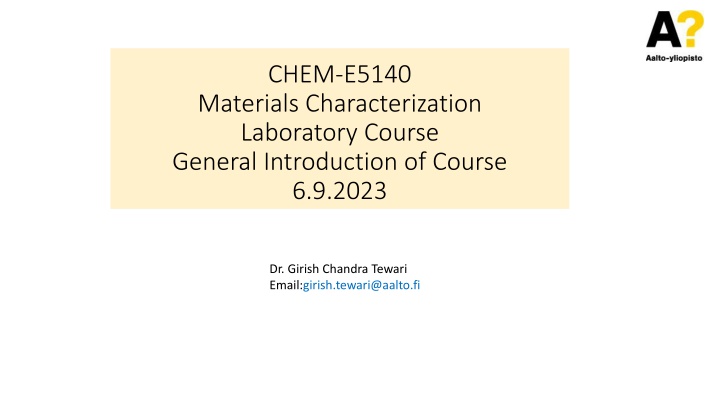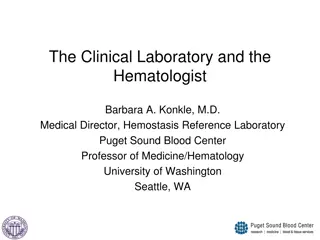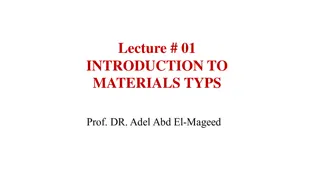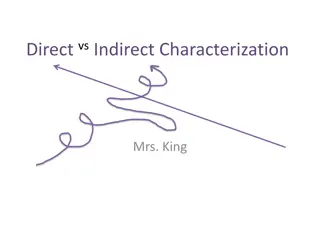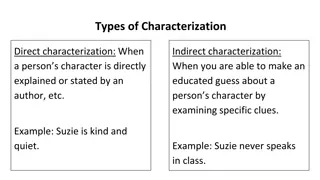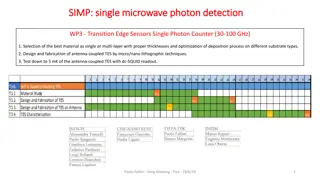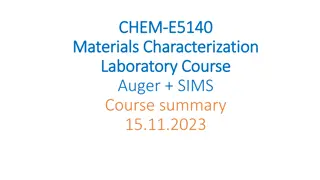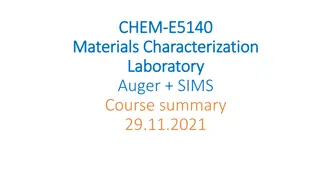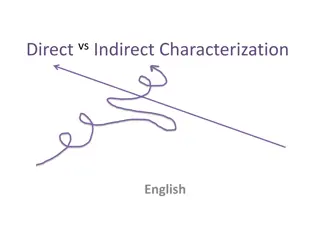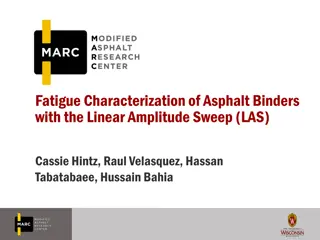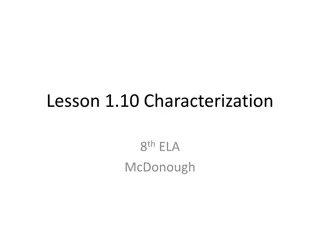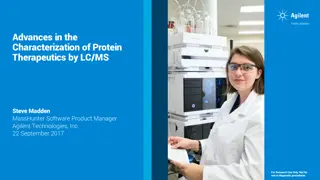Materials Characterization Laboratory Course Overview
Learning about material characterization in the CHEM-E5140 Materials Characterization Laboratory Course includes understanding physical and chemical properties of various materials, such as bulk, surfaces, and nanostructures. The course structure involves lectures, lab sessions, assignments, and end-semester exams. Students will engage in practical laboratory practice, data collection, analysis, and interpretation to probe the properties of different materials. Passing the course requires participation in lab exercises, reports, oral exams, and feedback, while emphasizing no tolerance for plagiarism.
Download Presentation

Please find below an Image/Link to download the presentation.
The content on the website is provided AS IS for your information and personal use only. It may not be sold, licensed, or shared on other websites without obtaining consent from the author.If you encounter any issues during the download, it is possible that the publisher has removed the file from their server.
You are allowed to download the files provided on this website for personal or commercial use, subject to the condition that they are used lawfully. All files are the property of their respective owners.
The content on the website is provided AS IS for your information and personal use only. It may not be sold, licensed, or shared on other websites without obtaining consent from the author.
E N D
Presentation Transcript
CHEM-E5140 Materials Characterization Laboratory Course General Introduction of Course 6.9.2023 Dr. Girish Chandra Tewari Email:girish.tewari@aalto.fi
Learning Outcomes: Material Characterization Introduction to course Course Structure (Lectures, Lab Sessions, Assignments and Feedback) End Semester Exams
Material Characterization Probing physical and chemical properties of materials (Bulk, Surfaces and nanostructures) Bulk/powder(3D) Thin films(2D) Nanostructures(1D and 0D) Contact Session (Theoretical Background (Principle , Instrumentation, data collection & data analysis)) Laboratory practice How to measure and extract data? How do I get the information that I need? Analysis of data
Teaching and Lab acitivites Major Topic 2 Report Major Topic1 Pre-task Feedback Read Class Laboratory Week 1 Week 2 Week 3 Minor topic Week 4 Class Pre-task Read Week 2 Week 1
Teaching and Lab activities Period I Week Contact session Laboratory Pre-task 36 General Introduction - XRD 37 XRD XRD TEM 38 TEM - Four probe resistivity and Hall effect in semiconductors 39 Four probe resistivity and Hall effect in semiconductors Four probe resistivity and Hall effect in semiconductors Optical Microscopy(OM) 40 Optical Microscopy (OM) SEM 41 SEM SEM EDS 42 Exam week - -
Teaching and Lab activities Period II Week Contact session Laboratory Pre-task 43 EDS Atomic Force Microscopy (AFM) 44 Atomic Force Microscopy (AFM) Atomic Force Microscopy (AFM) Raman 45 Raman Raman XPS Auger + SIMS 46 XPS 47 Auger + SIMS Course Summary - - 48 - Oral Exam slots (2.12) - 49 - Oral exam slots (5.12- 6.12) -
How to pass the course? 5 laboratory exercises At least 4 laboratory participations are required to pass the course [get to the exam] If you miss one -> extended report (explain things in more details. Do review more number of papers for data on different materials) 5 laboratory reports (major topics) (including the pre-task), 60 % Oral Exam and other tasks, 36 % Feedback 4% Plagiarism: I do not tolerate! Always additional work!
Material All the course material will be at MyCourses Used also for submission and lab booking I will add the lecture slides AFTER the lecture As well the material we produce during lectures Final DL for ALL submissions 10.12 at 8 pm
Course Book Free e-book for Aalto students Course book index (which pages are most relevant for the course and exam)
Flip the class room Before every major/minor topic, study the topic from course book and prepare your pre-task With minor topics, strongly recommended, but not obligatory! [Read rather then not on exam] Exam is based on the material on Course book! At class, we do less studying and more doing
Laboratory work XRD Four Probe Resistivity and Hall Measurement Scanning Electron Microscopy (SEM) Atomic Force Microscopy (AFM) Raman Raman microscope, www.nano.pitt.edu, 19.8.2015 Select group from MyCourses Assignments (one/each work) Arrive on time In a case of sudden illness try to change the time with a friend (no additional lab times!)
How to sign in a laboratory group If you know you can not attend, do not book a time!
How to sign in a laboratory group Always try to book other than the last group, to add some flexibility, If you get sick, cancel your group and book the last session!
Laboratory work XRD Four probe resistivity and Hall effect Scanning Electron Microscopy (SEM) Atomic Force Microscopy (AFM) Raman Spectroscopy Take pictures during the lab work and use them in your report Selfie with the equipment Take a group selfie with the equipment (confirm that you were in the lab) -> include to your report (cover page)
Laboratory instructions? No Why not? Learning outcome: How to listen in laboratory How to prepare notes Parameter s might change This is a Master s level, these are considered that you are working as a researcher! Learn to be Present at the lab Not to sleep in the lab Just 2 h - > Focus (lab coat, gloves and goggles) Come to Lab with laboratory gears B112b hall C113 hallway cabinet
Laboratory report Format is power point Why? Visualize your story Compact message Difficult to copy-paste
Pre-task: How to prepare Prepare 4-6 slides Theoretical principle of the method? What information you get ? What kind of samples can be analysed? Is the method destructive for the sample? Questions for the expert terrapinsa005.weebly.com Your picture of the operating mechanism of the device (drawn with hand or by yourself with computer)
Pre-task (flip): How to prepare terrapinsa005.weebly.com Prepare 4-6 slides Theoretical principle of the method? What information you get ? What kind of samples can be analysed? Is the method destructive for the sample? Questions for the expert Your picture of the operating mechanism of the device (drawn with hand or by yourself with computer) Bring the homework to class (we work with them)
Pre-task (flip): How to prepare Prepare 4-6 slides: Theoretical principle of the method? What information you get ? What kind of samples can be analysed? Is the method destructive for the sample? Questions for the expert and ask them during the lecture and lab work response to your report (required for higher grades) Your picture of the operating mechanism of the device (drawn with hand or by yourself with computer) terrapinsa005.weebly.com Submit to MyCourses before the lecture (max size 5 MB) Use it as Introduction for your laboratory report
How to hand in pre-task Remember to submit Before the lecture
Laboratory report: How to prepare Introduction: your pre-task + operating image This you already have! www.somervillenjk12.org
Laboratory report: How to prepare Introduction: your pre-task + operating image Also add here the group selfie (confirmation your presence) This you already have! www.somervillenjk12.org
Laboratory report: How to prepare Introduction: your pre-task + operating image Experimental: the procedure (what did you do in the lab) Can involve text and pictures (you take in lab) Here if any sample preparation done www.somervillenjk12.org
Laboratory report examples: Experimental microscope/camera detector Explain with power point! Visualizing! sample spectrometer direction of the laser laser
Laboratory report: Experimental - samples Take images of your samples, and tell in detail what they are. Image 2: Amylose from a potato Image 1: Bottle containing amylose from a potato Image 3: Treated barley seeds
Laboratory report: How to prepare Introduction: your pre-task + operating image Experimental: the procedure Results: the result obtained Data presented in a clear way Compare the data to other researcher (for higher grade) www.somervillenjk12.org
Laboratory report examples: Results Remember to present you data in a clear form (easy for the reader to understand) You can also highlight the wanted results
Laboratory report: How to prepare Introduction: your pre-task + operating image Experimental: the procedure Results: the result obtained Discussion: Analysis of the results You can do the data analysis with peers but - >Each of you will write their own report No need for long discussion (bullet points) www.somervillenjk12.org
Laboratory report examples: Analysis
Laboratory report: How to prepare Introduction: your pre-task + operating image Experimental: the procedure Results: the result obtained Discussion: Analysis of the results Conclusions: 1 slide for technical conclusions 1 slide for reflection www.somervillenjk12.org
Laboratory report: How to prepare Introduction: your pre-task + operating image Experimental: the procedure Results: the result obtained Discussion: Analysis of the results Conclusions References: add here all references used www.somervillenjk12.org
Plagiarism Aalto University Examination Guidelines | Aalto University https://www.aalto.fi/en/applications-instructions-and-guidelines/aalto-university-examination- guidelines?check_logged_in=1 Aalto University Code of Academic Integrity and Handling Violations Thereof | Aalto University https://www.aalto.fi/en/applications-instructions-and-guidelines/aalto-university-code-of-academic-integrity-and- handling-violations-thereof 32
Proper Reference Example: A. Santasalo-Aarnio, A. Lokkiluoto, J. Virtanen, M.M. Gasik, Performance of electrocatalytic gold coating on bipolar plates for SO2 depolarized electrolyser. J. Power Sources306 (2016) 1-7. Journal paper: 1. Authors 2. Title of the paper 3. Journal name 4. Volume Year Page numbers 5. Possible DOI (if very new) -> No Science direct/Research gate links (the links might not exist when I m looking at them) - > Reference style is free (as long as having the 4 component)
Proper Reference Web pages: 1. Author/s (if not known. Annon.) 2. Title of the page/section 3. Link 4. When visited (date) Annon. Nanoparticle - Definition. https://en.wikipedia.org/wiki/Nanoparticle, visited 11.9.2017.
Learning Outcomes of the Laboratory and Reports Be present at laboratory situation Keep excellent record on procedures/parameters Explain the phenomena behind the experimental method Present the obtained data in a clear, reader friendly form Relate it to other measured references Prepare good experimental conclusions Learn to reflect on own laboratory skills Growth path for professionalism
MyCourses Report Submission Submit report The submitted file can only be 20 MB! Dead line is given inside this section for each report
Laboratory report: Assessment Introduction: Experimental: Results: Conclusions and reflection: Total 3 p. 3 p. 3 p. 3 p. 12 p. Submission late pretask (-1 p.) and/or report (-1 p.)! www.somervillenjk12.org
Laboratory report: Assessment matrix (MyCourses) 0 p. 1 p. 2 p. 3. p. Pre-task - No clear individual contribution The students does not understand the method No questions - Light description of the method - And/or Parts lacking - Question lacking or not reported - Proper description of the method The student shows clear understanding of the method Student reported questions - The student has understood thoroughly the method and it s constrains - Student reported questions - - - - Experimental - Image of equipment List of activities - Image and parts of the equipment explained Light description of the activities during the labwork - Identify the purpose of parts of the equipment Detailed description of activities in lab - Identify the purpose of parts of the equipment Understanding the reasons behind the activities - - - -
Laboratory report: Assessment matrix (MyCourses) 0 p. 1 p. 2 p. 3. p. Intro/Pretask - No clear individual contribution The students does not understand the method Parts lacking - - Light description of the method And/or Parts lacking - No question or not asked/reported - Description of the method The student has understood the method At least one questions to experts asked/reported - The student has understood thoroughly the method and it s constrains Various questions asked/reported - - - - - - - Experimental - Image of equipment List of activities - Image and parts of the equipment explained Light description of the activities during the labwork - Image and parts of the equipment explained Identify the purpose of parts of the equipment Detailed description of activities in lab - Identify the purpose of parts of the equipment - Detailed description of activities in lab Understanding the reasons behind the activities - - - - -
Laboratory report: Assessment matrix (MyCourses) 0 p. 1 p. 2 p. 3. p. Results - Figure/spectra presented No or very light comments on data No data comparison - Data not modified (if required) Some/Light comments on data No data comparison - Data modified (if required) Proper analysis of data Some data comparison with additional reference - Data modified to facilitate the interpretation Detailed analysis of data and data comparison with additional reference - - - - - - - Conclusion - What can be seen in the results No reflection Only one reference (course book) -Obvious conclusions of the data -Some reflection -1-2 references - Conclusions with connection to theory - Relevant reflection > 2 references - Detailed conclusions with connection to theory - Deep reflection - Various scientific journals as reference + - Reflection - + Reference
Laboratory report: Assessment matrix (MyCourses) 0 p. 1 p. 2 p. 3. p. Results - Figure/spectra presented No or light comments on data No data comparison - Data not modified (if required) Light comments on data No data comparison - Data modified (if required) Proper analysis of data Some data comparison with additional reference - Data modified to facilitate the interpretation Detailed analysis of data - Deep data comparison with additional references - - - - - - - Conclusion - Conclusions with connection to theory - Relevant reflection - Various properly prepared references - What can be seen in the results - No reflection - Minimum references (course book) + Obvious conclusions of the data -Some reflection -Few references Detailed conclusions with connection to theory - Deep reflection - Various reference Reflection + Reference
What is reflection? You already have a degree you already know something of the method(techniques) With reflection you connect the past and present knowledge build a bridge between them: What did you know before of this topic How is this related on something else you already knew What was new to you? We practice this here at each class! studiojoslizen.wordpress.com
Course assessment 1. Laboratory report Laboratory report (5 x 12p.) 2. End sem exam and feedback Oral exam - A method (max. 18p.) Analysis of the data: case study 18 feedback webpropol 4 total 100 p. 60 p. 60 18 Minimum 60 p. to pass the course Grade table provided after all oral exams completed
Oral Exam First task You can book a time if you have -Participated in 4 laboratories! Describe a method All the methods learned at the course are in my doctoral hat you will take one and answer to questions: 1. Theoretical principle of the method, what information you get and how does it work? (0-6 p.) 2. What kind of samples can be analysed? (0-6 p.) 3. What could a possible result look and how is it analysed? (0-6 p.)
Oral Exam Second task Real case (from a published paper):A material has been created 18 p. What is the studied sample and how is it synthesized? What different methods were used > What information did each of the method provide? Data of the selected method, what interpretations can be made? Was the characterization sufficient, would some more information be needed? Critically evaluate, if you keep the study reliable http://www.ceriumlabs.com/104/Q2_2010_Newsletter.htm, 19.8.2015
What if you just dont have time to finish the course Pretask + Laboratory work + Report Accepted combination of these three -> can be utilized at later years! -> If one of these items is missing, you need to redo the whole lab
Using AI in This Course You are NOT allowed to use AI in Exercises or Exam One goal of this course is to learnhow to find and read scientific, peer-reviewed papers yourself and discuss about contradictory data You need to show your own understanding in the answers 47
Materials Characterization Let s start
